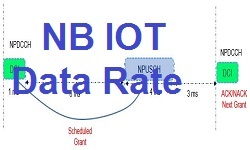NB-IoT PRBs (Physcial Resource Blocks) for In-Band Operation
NB-IoT or NB-LTE is a new 3GPP radio-access technology. NB-LTE requires 200 kHz minimum system bandwidth for both downlink and uplink, respectively. The choice of minimum system bandwidth enables a number of deployment options like a GSM operator can replace one GSM carrier (200 kHz) with NB-IoT or a LTE operator can deploy NB-LTE inside an LTE carrier by allocating one of the Physical Resource Blocks (PRB) of 180 kHz to it. This minimum bandwidth 200 KHz requirement enables three possible modes of operation of NB-LTE which are mentioned as below and illustrated in figure.
- In-band Operation using one PRB of a LTE carrier
- Guard band Operation by using used Resource Blocks within LTE carrier Guard Band
- Standalone Operation by using a GSM 200KHz carrier

For in-band deployment, not all frequencies, i.e. resource blocks within the LTE carrier, can be used for NB-IoT cell connection. For the UE to synchronise and acquire the NB-IoT cell, for an in-band downlink anchor carrier, the PRB is restricted to the values shown in Table below. For uplink carrier and nonanchor, there is no limitation. For standalone and guard-band operation mode, the downlink and uplink carrier should be set symmetrically.
| LTE System Bandwidth | 3 MHz | 5 MHz | 10 MHz | 15 MHz | 20 MHz |
|---|---|---|---|---|---|
| LTE PRB indices for NB-IoT Synchronization |
2, 12 | 2, 7, 17, 22 | 4, 9, 14, 19, 30, 35, 40, 45 |
2, 7, 12, 17, 22, 27, 32, 42, 47, 52, 57, 62, 67, 72 |
4, 9, 14, 19, 24, 29, 34, 39, 44, 55, 60, 65, 70, 75, 80, 85, 90, 95 |
As indicated in this table, there is no support for In-band operation of an LTE 1.4 MHz bandwidth. A conflict between resources used by the LTE system like the cell specific reference signals (CRS) or the downlink control channel at the start of each sub-frame must be taken into account when resources are allocated for NB-IoT. This is also reflected in Table by not using the 6 inner resource blocks, as these are allocated for the synchronization signals in LTE.



